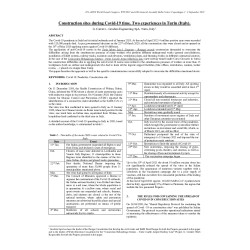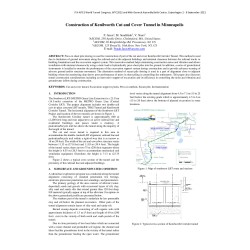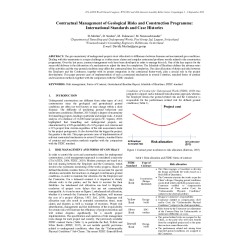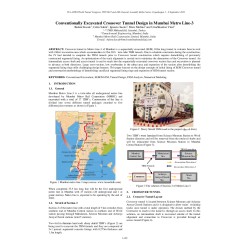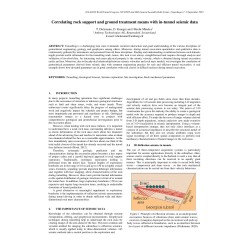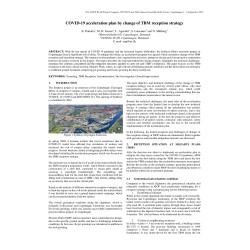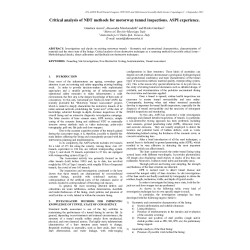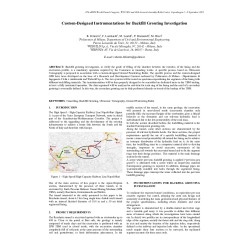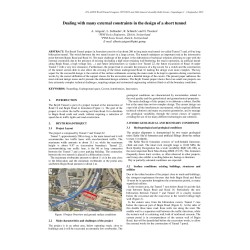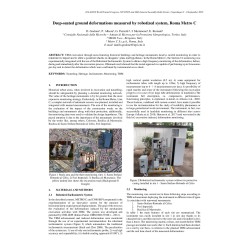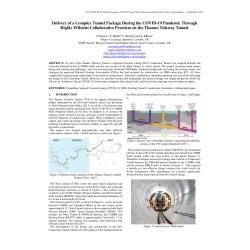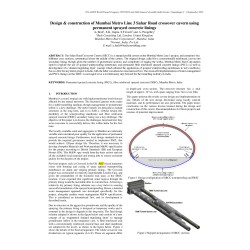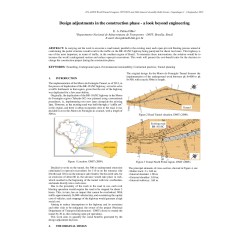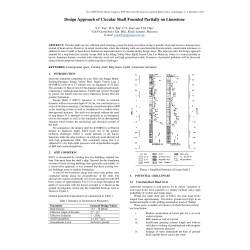No document
Search & filter
Search for a publication
Search & filter
Papers from WTC and ITA conferences have been made available as PDF documents.
ProceedingsThere are 1984 documents.
List of endorsed conferences
-
WTC
World Tunnelling Congress
-
Construction of the Metro Station in Restrained Urb an Development
Abstract: In the historical center of St. Petersburg, all metro stations are deep level stations because stable dry soils underlay here at the depth of more than 40 m. One of the stations under construction is "Teatralnaya" station, located close to Mariinskiy Theater, which is a listed building. "Teatralnaya" is a pylon-type station with laying depth of about 60 m is constructed in reinforced concrete...
0,00 € -
Construction sites during Covid-19 time. Two experi ences in Turin (Italy).
Abstract: ABSTRACT The Covid-19 pandemic in Italy had its initial outbreaks end of January 2020. At the end of April 2021 4 million positive cases were recorded with 120,000 people died. As per governmental decision on the 22nd of March 2020, all the construction sites were closed and re-opened on the 16th of May 2020 applying norms against Covid-19 diffusion. The application of anti-Covid-19 norms in...
0,00 € -
Construction of Kenilworth Cut and Cover Tunnel in Minneapolis
Abstract: Press-in sheet pile shoring is used for construction of part of the cut and cover Kenilworth Corridor Tunnel. This method is used due to limitation of ground movement along the railroad and at the adjacent buildings and minimal clearance between the railroad tracks or building foundations and the excavation support system. This innovative method helps minimizing construction noise and vibration...
0,00 € -
Contractual Management of Geological Risks and Construction Programme International Standards and Case Histories
Abstract: The geo-uncertainty of underground projects most often leads to differences between foreseen and encountered geo-conditions. Dealing with this uncertainty is a major challenge as it often raises claims and complex contractual problems mostly related to the construction programme. Over the last years, contract management tools have been developed in order to manage this risk. One of the key...
0,00 € -
1 of 9 Conventionally Excavated Crossover Tunnel Designin Mumbai Metro Line -3
Abstract: Crossover tunnel in Metro Line-3 of Mumbai is a sequentially excavated (SEM) 103m long tunnel in volcanic breccia rock with 180m2 excavation area which accommodates 6.35m O.D. twin tube TBM tunnels. Due to schedule constraints during the construction, the JV had decided to complete the TBM tunnels prior to Crossover tunnel construction which requires demolishing of previously constructed...
0,00 € -
Correlating rock support and ground treatment means with in -tunnel seismic data
Abstract: Tunnelling is a challenging task since it demands recurrent interaction and good understanding of the various disciplines of geotechnical engineering, geology and geophysics among others. Moreover, during tunnel excavation quantitative and qualitative data is continuously gathered by instruments and personnel from all these disciplines. Finding and understanding correlations between such...
0,00 € -
COVID -19 acceleration planby change of TBM reception strategy
Abstract: With the fast spread of COVID 19 pandemic and the increased logistic difficulties, the Sydhavn Metro extension project in Copenhagen faced a significant risk of delay. To mitigate this delay, an acceleration program was agreed, which included a change of the TBM reception and launching strategy. The response to the pandemic crisis required fast decisions, prompt re-design and close proactive...
0,00 € -
Critical analysis of NDT methods for motorway tunnel inspections - ASPI experience
Abstract: Investigations and checks on existing motorway tunnels - Geometric and constructional characteristics, characterization of materials and the stress state of the linings. Critical analysis of non-destructive techniques as a screening method for possible critical issues – Methodological checks, direct calibrations and feedback non-destructive techniques.
0,00 € -
Custom-Designed Instrumentations for Backfill Grouting Investigation
Abstract: Backfill grouting investigation, to verify the grade of filling of the chamber between the extrados of the lining and the excavation profile, is a mandatory operation required by the Customers in tunneling works. A specific process based on Ultrasonic Tomography is proposed in association with a custom-designed Ground Penetrating Radar. The specific process and the custom-designed GPR have been...
0,00 € -
Data Management System for the S1S2 Tunnels of the High -Speed 2 Link Project in
Abstract: The S1/S2 contract for the new High Speed 2 (HS2) in the United Kingdom linking London to Birmingham and later Leeds and Manchester will consist of 22 km of tunnels and is estimated to cost GBP 3.3 billion. As part of the contract, an Instrumentation & Monitoring data management system to support the construction phase (Phase 2) is provisioned. This paper discusses the development of the data...
0,00 € -
Dealing with many external constraints in the design of a short tunnel
Abstract: The Beyth Tunnel project in Jerusalem consists of an about 200 m long main road tunnel (so-called Tunnel 7) and a 60 m long bifurcation tunnel. The switch between the two tunnel occurs in a large cavern. The tunnels underpass an important road at the intersection point between Begin Road and Road 16. The main challenge of the project is the elaboration of technical solutions allowing to cope...
0,00 € -
Deep -seated ground deformations measured by robotized system, Roma Metro C
Abstract: TBM excavation through areas featuring historical buildings and heritage monuments deserve careful monitoring in order to minimize its impact and to allow a posteriori checks on designers’ plans and hypotheses. In the Roma Metro C, the Section T3 monitoring was experimentally integrated with the use of the Robotized Inclinometric System to obtain a high frequency monitoring of the deformation,...
0,00 € -
Delivery of a Complex Tunnel Package During the COVID -19 PandemicThrough
Abstract: As part of the Thames Tideway Tunnel, a Sprayed Concrete Lining (SCL) Connection Tunnel was required between the Carnwath Road Riverside (CARRR) Shaft and the west section of the Main Tunnel in a short period. This project presented some unique design and construction challenges, such as excavating near the buried TBM body, breaking through and excavating the existing tunnel, and changing the...
0,00 € -
Design and construction of Mumbai Metro Line3 Sahar Road crossover cavern using
Abstract: The Sahar Road Crossover Cavern (SRCC) is a stepped profile cavern on the Mumbai Metro Line 3 project, and comprises 6no. different cross sections, symmetrical about the middle of the cavern. The original design called for a conventionally reinforced, cast-in-situ secondary lining, though given the number of geometrical sections and complexity of staging the works, Mumbai Metro Rail Corporation...
0,00 € -
Design adjustments in the constructionphase - a look beyond engineering
Abstract: In carrying out the work to excavate a road tunnel, parallel to the existing road, each open-pit rock blasting process aimed at conforming the portal structure would result in the traffic on the BR-101/SC highway being paralyzed for about two hours. This highway is one of the most important, in terms of traffic, in the southern region of Brazil. To minimize these interventions, the solution...
0,00 € -
Design Approach of Circular Shaft Founded Partially on Limestone
Abstract: Circular shafts are very efficient earth retaining system for deep excavation owing to transfer of ground stresses via hoop stress instead of beam action. However, in actual construction where the retaining walls are constructed in discrete panels, construction tolerances in addition to risk of uplift or basal heave failures are important factors to consider during design stage. This paper...
0,00 €



